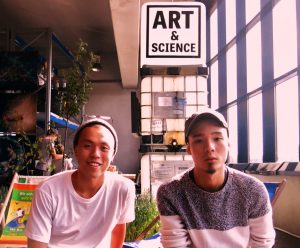Healing through Art and Technology
062720150832 484 15 44 % 18-29 ∞
These numbers represent an incident that shocked Taiwanese society—the Formosa Fun Coast explosion. The incident happened three years ago, total injuries were 484 people, including 15 deaths, with 44 percent burns to their bodies. The victims were young people between the ages of 18 and 29. Many of the burns patients are still undergoing physical and psychological treatment.
“Etude”, a project created by the digital artist Hsin-Jen Wang aims to bring back a colorful future to young victims through music, art and technology. The patients can compose their own melodies using an application created by the digital artists, which acts as an interactive game using the Kinect technology, engaging them by making the process of rehabilitation a funny activity.
“Etude” was performed by the Taiwanese digital musicians Vibert Thio and Duanger Du, during the opening of the Ars Electronica Festival 2017 in Linz (Austria) three weeks ago. Based on the users’ composing record, digital artists extracted melody patterns and generated music from algorithms by using live coding techniques, known as algorithmic rave. Digital artists performed as improvisers, creating live music and a party interacting with the audience. The showcase acts as a platform that documents how these music therapy sessions changed methods of rehabilitation and fine arts. The show also dispatches a drone-mounted camera to capture the audience reactions to these developments.

“The hospital managers guided us in the process of choosing the best gestures for the rehab in connection with the requirements of the app. The same gesture will detect the sound and in the performance we can choose any sound recorded”, told the digital artists Vibert Thio and Duanger Du to Probeta Mag, who interviewed them at Ars Electronica Festival 2017. Thio developed the digital programming and made use of the data from the videos of ten hundred victims by encrypting them into his video output during the performance. Du was in charge of the sound managing.
Advised by the Ministry of Culture of the Republic of China, and funded by Quanta Art Foundation, Quanta Computer and Ars Electronica, Ruei Yen, project manager of Quanta Art Foundation, explained that “We use “Etude” to develop the future of visual arts connected with humanity and social care”.
Video credit: Quanta Art Foundation
#Cultural Data
The algorave is an international music movement with a community of electronic musicians, visual artists and developing technologies. It can include a range of styles, including a complex form of minimal techno, and has been described as a meeting point of hacker philosophy, geek culture, and clubbing. Although algorave musicians have been compared with DJs, they are in fact live musicians or improvisers, creating music live, usually by writing or modifying code, rather than mixing recorded music.
At an algorave the computer musician may not be the main point of focus for the audience and instead attention may be centered on a screen that displays live coding, that is the process of writing source code, so the audience cannot just dance or listen to the music generated by the source code, but also to see the process of programming.
Algorithmic approaches have long been applied in electronic dance music, including by Farmers Manual, Autechre, and Aphex Twin. The name was first coined in 2011, after live coders Nick Collins and Alex McLean tuned into a happy hardcore pirate radio station on the way to a performance in the UK. Since then, it has been growing into an international movement, with algoraves having been held mainly in Europe and Asia, and few events in Australia and North America.


